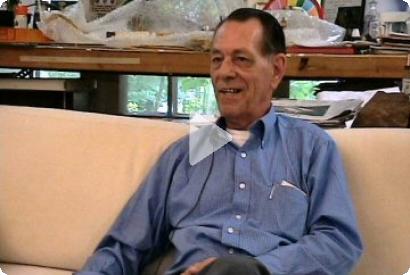Please wait a few moments while we process your request

Per Biorn
1937, Copenhagen (Denmark); 2015, Gainesville (Florida, U.S.)
After completing his military service in Denmark, Per Biorn studied electrical engineering, then emigrated to the United States in 1962. He began working for Bell Telephone Laboratories (Murray Hill, N.J., U.S.) in 1964, focusing primarily on solid-state circuit research. For 9 Evenings, Biorn designed the technological components controlling various elements (projectors, objects, lights) for Carriage Discreteness by Yvonne Rainer. In addition, he developed some of the TEEM decoders and helped design the Ground Effect Machine used in Vehicle by Lucinda Childs.
As an engineer participating in Experiments in Art and Technology (E.A.T.), Biorn was asked by Marta Minujin to design the interactive elements of her installation Minuphone (1967). As part of another E.A.T. collaboration (with Ralph Flynn and Robby Robinson), he developed the light and sound modulation system used by Carolee Schneeman in her performance Snows (1967).
In 1968, Biorn built some of the interactive elements of the Soundings and Solstice installations (1968) by Robert Rauschenberg. During the 1990’s, he restored these works and occasionally fine-tuned the technology for the artist retrospectives.
In 1970, Biorn built several components for the sound dispersion system in the Pepsi Pavilion designed by E.A.T. for the Osaka World Exposition held that year. Since 1966, Biorn has also worked with Lillian Schwartz (1968), Merce Cunningham (1969), Jean Toche (1970), Julius Tobias (1972), Trisha Brown (1986), Lillian Ball (1991, 1993), Irina Nakhova (1994), Robert Whitman (1995), Nina Sobell (2001), and Marjorie Gamso (2002).
[Documents available in the collection about Per Biorn...]
[Documents available in the collection by Per Biorn...]
As an engineer participating in Experiments in Art and Technology (E.A.T.), Biorn was asked by Marta Minujin to design the interactive elements of her installation Minuphone (1967). As part of another E.A.T. collaboration (with Ralph Flynn and Robby Robinson), he developed the light and sound modulation system used by Carolee Schneeman in her performance Snows (1967).
In 1968, Biorn built some of the interactive elements of the Soundings and Solstice installations (1968) by Robert Rauschenberg. During the 1990’s, he restored these works and occasionally fine-tuned the technology for the artist retrospectives.
In 1970, Biorn built several components for the sound dispersion system in the Pepsi Pavilion designed by E.A.T. for the Osaka World Exposition held that year. Since 1966, Biorn has also worked with Lillian Schwartz (1968), Merce Cunningham (1969), Jean Toche (1970), Julius Tobias (1972), Trisha Brown (1986), Lillian Ball (1991, 1993), Irina Nakhova (1994), Robert Whitman (1995), Nina Sobell (2001), and Marjorie Gamso (2002).
[Documents available in the collection about Per Biorn...]
[Documents available in the collection by Per Biorn...]
Vincent Bonin © 2006 FDL
Index:
- 9 Evenings: Finding Aids
• Fonds
• Series
- Documents associated with 9 Evenings
- Documentary films on 9 Evenings
• General bibliography
Related pages:
 9 Evenings: Theatre and Engineering fonds, Interview with Per Biorn
9 Evenings: Theatre and Engineering fonds, Interview with Per BiornThis interview with Mr. Biorn, produced by the Daniel Langlois Foundation, was taped on August 25, 2004, in Berkeley Heights (NJ, U.S.). Present at the interview were Julie Martin, Vincent Bonin and Éric Legendre.
 9 Evenings: Theatre and Engineering fonds, Finding Aids
9 Evenings: Theatre and Engineering fonds, Finding AidsIn 1965, Billy Klüver sought the expertise of some 30 engineers at Bell Labs, requesting that they participate in an project blending avant-garde theatre, dance and new technologies.


